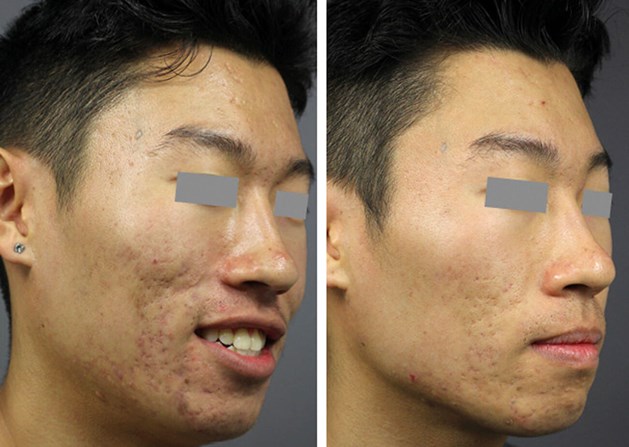Attain Smooth Skin with Specialized Acne and Acne Scars Treatment
Attain Smooth Skin with Specialized Acne and Acne Scars Treatment
Blog Article
Discovering Skin Disease: Dealing With and recognizing Acne Scars for Healthier Skin
Acne scars represent a considerable concern for individuals looking for to preserve healthy skin, as they can affect both look and self-worth. Recognizing the various kinds of scars, from atrophic to hypertrophic, is important for identifying appropriate treatment alternatives. While expert interventions like chemical peels and microneedling can be effective, the significance of customized treatment plans can not be overstated. Furthermore, preventative procedures play an essential role in decreasing future scarring. As we check out these aspects, one need to think about just how the ideal technique can lead to transformative outcomes.
Understanding Acne Scars
Comprehending acne marks is vital for any person that has actually experienced severe acne, as these marks can have a long lasting influence on both physical look and psychological wellness. When the skin undertakes inflammatory feedbacks throughout energetic acne lesions, acne marks develop. The intensity of scarring is commonly influenced by elements such as the kind of acne, its period, and specific skin features.
The body's natural recovery procedure can lead to either atrophic marks, which look like anxieties in the skin, or hypertrophic marks, which are raised and result from overproduction of collagen. In addition, the psychological toll of acne scars ought to not be taken too lightly; numerous people report feelings of humiliation, stress and anxiety, and decreased self-esteem. This emotional problem can impact social interactions and overall high quality of life.
Dealing with acne marks calls for a comprehensive understanding of their development and impact. Understanding of the possibility for long-term consequences connected with neglected scars can encourage people to seek appropriate treatments. Early intervention and effective administration methods can dramatically enhance skin appearance and boost psychological resilience, highlighting the relevance of recognizing the intricacies bordering acne marks.
Sorts Of Acne Scars
Acne marks can be categorized right into unique kinds, each exhibiting distinct features and calling for certain therapy approaches. The primary kinds of acne marks include atrophic, hypertrophic, and keloid scars.

Hypertrophic scars, in contrast, are elevated over the skin level and are the result of too much collagen manufacturing during the healing process. They commonly stay within the borders of the initial acne lesion. Keloid marks are comparable but expand beyond the original injury site, forming bigger, increased areas that can be scratchy or uncomfortable.
Comprehending these sorts of scars is important for picking suitable treatment choices. Different scars might react better to certain therapies, more helpful hints such as laser treatments, fillers, or surgical interventions, stressing the value of a customized technique to acne scar monitoring.
Recognizing Your Scars
Acne marks normally fall into two classifications: atrophic and hypertrophic marks. These can further be classified into ice-pick scars, boxcar scars, and rolling scars, each displaying distinctive qualities and requiring different approaches for analysis - acne scars treatment.
Hypertrophic scars, on the other hand, are elevated and happen due to excessive collagen production throughout the healing process. Identifying the specific functions of your scars-- such as width, deepness, and structure-- is vital for appropriate identification. Furthermore, take into consideration the circulation of marks across your skin, as this can show the extent and duration of the acne condition.
Engaging with a dermatologist can supply valuable insights into the nature of your marks, assisting in the distinction between different types. A complete understanding of your scars will ultimately result in a more customized and efficient therapy strategy, making sure a clearer and much healthier complexion.
Treatment Options Offered
Recognizing the specific type of acne scars existing on your skin prepares for exploring efficient treatment choices. Typical kinds of acne scars consist of atrophic (clinically depressed), hypertrophic (elevated), and post-inflammatory erythema.
For atrophic scars, choices such as chemical peels, microneedling, and laser resurfacing are commonly made use of. Chemical peels utilize acids to get rid of the outer layer of skin, advertising brand-new cell development.
Hypertrophic marks can be treated with corticosteroid shots to squash the mark or laser treatment to minimize redness and boost look. acne and acne scars treatment. Silicone gel sheets and pressure dressings may additionally assist in handling raised marks
Furthermore, dermal fillers can momentarily complete anxieties from atrophic marks, while medical excision might be ideal for serious situations. Each therapy option has its considerations and advantages, making it necessary to speak with a dermatologist. They can supply individualized recommendations based on the kind and severity of your marks, as well as your skin kind and total health.
Tips for Prevention
Effective avoidance techniques can considerably minimize the likelihood of developing acne marks. The very first step is to maintain a regular skincare routine that consists of gentle cleansing, peeling, and hydrating. Making use of non-comedogenic products assists prevent stopped up pores, which can exacerbate acne. about his Furthermore, incorporating topical treatments having salicylic acid or benzoyl peroxide can effectively handle outbreaks and reduce swelling.
Preventing the impulse to pick or my sources stand out acne sores is critical, as this can lead to deeper skin damages and raise the risk of scarring. Instead, think about using a chilly compress or non-prescription therapies to reduce swelling and inflammation.
Sunlight defense is an additional vital element of avoidance; ultraviolet (UV) rays can dim marks and hinder the healing process. Applying a broad-spectrum sunscreen with a minimum of SPF 30 daily can secure the skin and advertise also recovery.
Last but not least, maintaining a well balanced diet plan abundant in antioxidants, vitamins, and minerals sustains skin health and wellness and recovery. Remaining moisturized and managing tension degrees can likewise play a significant duty in minimizing acne flare-ups. By implementing these techniques, people can considerably decrease their possibilities of establishing acne scars.

Final Thought
In conclusion, understanding and identifying acne marks is essential for reliable therapy and accomplishing healthier skin. Different kinds of acne marks, including hypertrophic and atrophic marks, demand details interventions tailored to specific demands.
The body's all-natural healing procedure can result in either atrophic marks, which appear as clinical depressions in the skin, or hypertrophic marks, which are raised and result from overproduction of collagen. They are further split into three subtypes: ice pick scars, boxcar marks, and rolling marks. Acne marks typically drop right into two categories: hypertrophic and atrophic scars. These can further be classified right into ice-pick marks, boxcar scars, and rolling marks, each showing unique attributes and requiring different approaches for assessment.
Various types of acne scars, consisting of hypertrophic and atrophic scars, necessitate specific interventions tailored to private needs.
Report this page